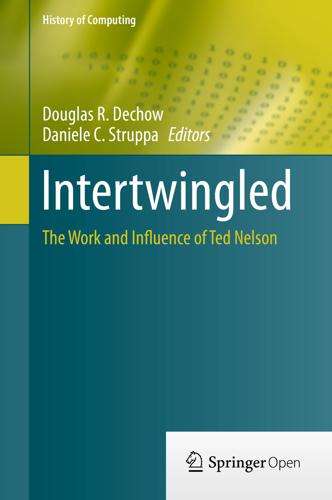
Intertwingled: The Work and Influence of Ted Nelson (History of Computing)
by
Douglas R. Dechow
Published 2 Jul 2015
US Patent 08/961,570, application dated 30 Oct 1997 Nelson TH (2001) Ted Nelson at ACM hypertext 2001 Streamed video. http://vimeo.com/15593138 Nelson TH (2001) Interactive connection, viewing and maneuvering system for complex data. http://www.google.com/patents/US6262736. US Patent application 09/530,857, application dated 15 Nov 1998 Nelson TH (2001) The future of information (scanned). May 4. http://web.archive.org/web/20010504071817/http://www.xanadu.com.au/ted/INFUTscans/INFUTscans.html Nelson TH (2001) Xanadu technologies – an introduction, 4 October.” http://xanadu.com/tech/ (A Joint Disclosure by Udanax.com and Project Xanadu as of August 23, 1999 to accompany our presentation at the O’Reilly Open Source Conference. … [Updated to reflect what was actually said at the meeting, with clarifications of the illustrations that were shown.
…
“Cleanup” of Draft dated 14 Oct. 1998 available under the title, “Transcopyright: Pre-Permission for Virtual Republishing” at: http://www.xanadu.com.au/ted/transcopyright/transcopy.html Nelson TH (1998) What’s on my mind. In: Invited talk at the first wearable computer conference. Fairfax VA. http://xanadu.com.au/ted/zigzag/xybrap.html. Written version of paper delivered to first Wearable computer conference Nelson TH (1998) Xanadu ZigZag hyperstructure kit: ZigZag commands for version 0.49. http://www.xanadu.com/zigzag/zzDirex.html. “System designed by Ted Nelson, programmed by Andrew Pam.
…
Anna Leahy provided editing for those talks. Douglas R. Dechow Daniele C. Struppa Orange, CA February 7, 2015 Contents Part I Artistic Contributions 1 The Computer Age Ed Subitzky 2 Odes to Ted Nelson Ben Shneiderman Part II Peer Histories 3 The Two-Eyed Man Alan Kay 4 Ted Nelson’s Xanadu Ken Knowlton 5 Hanging Out with Ted Nelson Brewster Kahle 6 Riffing on Ted Nelson—Hypermind Peter Schmideg and Laurie Spiegel 7 Intertwingled Inspiration Andrew Pam 8 An Advanced Book for Beginners Dick Heiser Part III Hypertext and Ted Nelson-Influenced Research 9 The Importance of Ted’s Vision Belinda Barnet 10 Data, Metadata, and Ted Christine L.

Memory Machines: The Evolution of Hypertext
by
Belinda Barnet
Published 14 Jul 2013
Apple presented HyperCard with much pomp and ceremony, but it was met with an undertone of disdain (as Joyce recalls it); the feeling was ‘we all knew systems that had a good deal more functionality, like FRESS, and we sort of resented being told, “here’s hypertext”’ (Joyce 2011a). Ted Nelson also presented a paper on Xanadu (‘All for One and One for All’) and Janet Walker presented a paper on the Document Examiner. ‘It was fabulous,’ recalls Joyce, ‘the whole hypertext world discovered one another’ (Joyce 2011a). The demos at Hypertext ’87 were literally at the center of the conference. One big room, lots of big systems, systems we’d been reading about for years but that you’d never actually seen before. There in one room: Ted Nelson’s Xanadu, Engelbart’s NLS/Augment, Walker’s Symbolics Document Explorer, Joyce and Bolter with Storyspace, [Bernstein’s] Hypergate, Meyrowitz and Landow and Yankelovich and van Dam with Intermedia.
…
Paisley and Butler (cited in Smith 1991, 262) have noted that ‘scientists and technologists are guided by “images of potentiality” – the untested theories, unanswered questions and unbuilt devices that they view as their agenda for five years, ten years, and longer.’ Memex has never been built, but like Ted Nelson’s Xanadu, it has become an image of potentiality for hypertext. It has also had a formative role in information science. The social and cultural influence of Bush’s inventions is well known, and his political role in the development of the atomic bomb is also well known. Bush was a very successful engineer who registered hundreds of patents and managed the development of weapons systems during World War II.1 What is not so well known is the way that Memex came about as a result of both Bush’s earlier work with analogue computing machines and his understanding of the mechanism of associative memory.
…
His team, however, became disillusioned with the vision and the new direction, and some of them migrated to PARC. However you slice it, NLS was no longer in serious use by the mid-1970s. The ideas, however, migrated to PARC and influenced all future hypertext systems. The premature death of a technical project like this is not uncommon. We will see it again in Ted Nelson’s legendary project, Xanadu, and we saw it in Memex’s failure to translate into technical vision. These visionary systems failed at different times and for different reasons, and we have inherited different aspects of their techniques, ideas and designs. But the charge of failure qua realization of technical vision, however partial or incomplete, 64 Memory Machines recurs as a motif in the evolution of hypertext, as does the dream of a perfect archive for human knowledge.
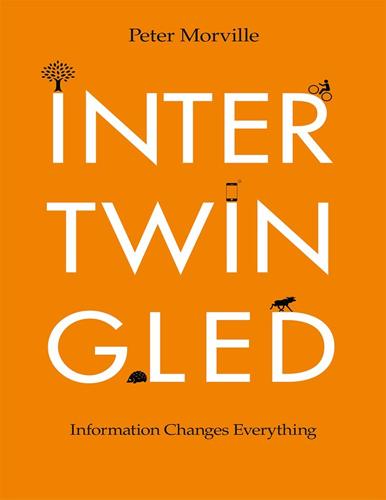
Intertwingled: Information Changes Everything
by
Peter Morville
Published 14 May 2014
lxii A “black swan” is a pivotal event that’s hard to predict or imagine in advance. Nassim Taleb popularized the term in his book, The Black Swan (2007). lxiii Soon Love Soon by Vienna Teng. lxiv Cataloging the World by Alex Wright (2014). lxv As We May Think by Vannevar Bush (1945). lxvi Project Xanadu by Ted Nelson, http://www.xanadu.com. lxvii A Research Center for Augmenting Human Intellect by Doug Englebart (1968). lxviii Englebart’s violin was a chorded keyboard designed to be used in concert with a traditional typewriter keyboard and a mouse. lxix The Design of Browsing and Berrypicking Techniques by Marcia J.
…
In 1934, Paul Otlet envisioned a scholar’s workstation that turned millions of 3 x 5 index cards into a web of knowledge by using a new kind of relationship known as the “Link.”lxiv In 1945, Vannevar Bush imagined the memex, a machine that enabled its users to share an associative “web of trails.”lxv In the early 60s, Ted Nelson coined “hypertext” and set out to build Xanadu, a non-sequential writing system with visible, clickable, unbreakable, bi-directional hyperlinks. lxvi Figure 3-1. Ted Nelson’s Xanalogical Structure. In 1968, Doug Englebart “real-ized” these dreams by showing hypertext (and most elements of modern computing) in “the mother of all demos.”lxvii Through the 70s and 80s, dozens of protocols and networks were made and merged, and in 1991, Tim Berners-Lee launched the World Wide Web as a public service on the Internet.
…
In all the dreams of hypertext, from Otlet and Bush to Nelson and Englebart, users were able to build and explore shared trails, but that’s not the realized model. In HTML, authors create one-way links inside the file. This simple, modular approach helped the Web to spread like wildfire, yet it also ruled out core features of earlier visions. Ted Nelson imagined a vertically integrated system that managed everything from code and interface to copyright and micropayment. Xanadu’s transpointing windows would support bidirectional links, transclusion, and side-by-side comparison. It would elevate the work of scholars and advance Doug Englebart’s dream to augment human intellect, so we might understand and resolve the world’s seemingly insoluble problems.
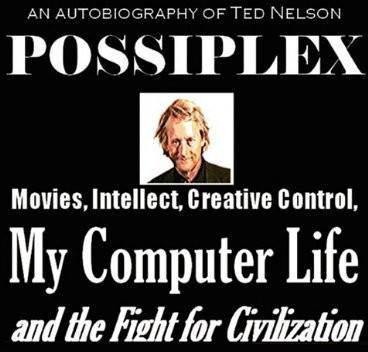
Possiplex
by
Ted Nelson
Published 2 Jan 2010
an autobiography of Ted Nelson POSSIPLEX • Movies, Intellect, Creative Control, My Computer Life and the Fight for Civilization First edition, 2010 POSSIPLEX: Movies, Intellect, Creative Control, My Computer Life and the Fight for Civilization, © 2010 Theodor Holm Nelson. All rights reserved. INTELLECTUAL PROPERTY NOTICES: The following are current trademarks of Project Xanadu, either registered or claimed: Xanadu® hypertext; XanaduSpace™; the Eternal-Flaming-X™ symbol ZigZag® database and software mechanisms; the Zigfinity™ symbol; Illusium™ multidimensional viewdata-- “The stuff that dreams are made of™”. UltiDimensional™ viewing. Transcopyright™ permission doctrine, content delivery and sale method.
…
Here is what he wrote in Weaving the Web (1999)— “Ted Nelson, a professional visionary,1 wrote in 1965 of "Literary 2 Machines," computers that would enable people to write and publish in a new, nonlinear format, which he called hypertext.3 Hypertext was "nonsequential" text, in which a reader was not constrained to read in any particular order, but could follow links and delve into the original document from a short quotation.4 Ted described a 5 6 7 futuristic project, Xanadu[® ], in which all the world's information could be published in hypertext. For example, if you were reading this book in hypertext, you would be able to follow a link from my reference to Xanadu to further details of that project. In Ted's vision, every quotation would have been a link8 back to its source, 9 allowing original authors to be compensated by a very small amount each time the quotation was read10.

Machine, Platform, Crowd: Harnessing Our Digital Future
by
Andrew McAfee
and
Erik Brynjolfsson
Published 26 Jun 2017
The web was born in 1989 when Tim Berners-Lee developed a set of protocols that allowed pieces of online content like text and pictures to link to each other, putting in practice the visions of hypertext first described by science and engineering polymath Vannevar Bush in 1945 (theoretically using microfilm) and computer visionary Ted Nelson, whose Project Xanadu never quite took off. The web rapidly turned the Internet from a text-only network into one that could handle pictures, sounds, and other media. This multimedia wonder, so much richer and easier to navigate than anything before, entered the mainstream in 1994 when Netscape released the first commercial web browser, named Navigator.
…
Bertram’s Mind, The” (AI-generated prose), 121 MySpace, 170–71 Naam, Ramez, 258n Nakamoto, Satoshi, 279–85, 287, 296–97, 306, 312 Nakamoto Institute, 304 Nappez, Francis, 190 Napster, 144–45 NASA, 15 Nasdaq, 290–91 National Association of Realtors, 39 National Enquirer, 132 National Institutes of Health, 253 National Library of Australia, 274 Naturalis Historia (Pliny the Elder), 246 natural language processing, 83–84 “Nature of the Firm, The” (Coase), 309–10 Navy, US, 72 negative prices, 216 Nelson, Ted, 33 Nelson, Theodore, 229 Nesbitt, Richard, 45 Netflix, 187 Netscape Navigator, 34 network effects, 140–42 defined, 140 diffusion of platforms and, 205–6 O2O platforms and, 193 size of network and, 217 Stripe and, 174 Uber’s market value and, 219 networks, Cambrian Explosion and, 96 neural networks, 73–74, 78 neurons, 72–73 Newell, Allen, 69 Newmark, Craig, 138 New Republic, 133 news aggregators, 139–40 News Corp, 170, 171 newspapers ad revenue, 130, 132, 139 publishing articles directly on Facebook, 165 Newsweek, 133 New York City Postmates in, 185 taxi medallion prices before and after Uber, 201 UberPool in, 9 New York Times, 73, 130, 152 Ng, Andrew, 75, 96, 121, 186 Nielsen BookScan, 293, 294 99Degrees Custom, 333–34 99designs, 261 Nixon, Richard, 280n Nokia, 167–68, 203 noncredentialism, 241–42 Norman, Robert, 273–74 nugget ice, 11–14 Nuomi, 192 Nupedia, 246–48 Obama, Barack, election of 2012, 48–51 occupancy rates, 221–22 oDesk, 188 Office of Personnel Management, US, 32 oil rigs, 100 on-demand economy, future of companies in, 320 online discussion groups, 229–30 online payment services, 171–74 online reviews, 208–10 O2O (online to offline) platforms, 185–98 business-to-business, 188–90 consumer-oriented, 186–88 defined, 186 as engines of liquidity, 192–96 globalization of, 190–92 interdisciplinary insights from data compiled by, 194 for leveraging assets, 196–97 and machine learning, 194 Opal (ice maker), 13–14 Open Agriculture Initiative, 272 openness (crowd collaboration principle), 241 open platforms curation and, 165 downsides, 164 importance of, 163–65 as key to success, 169 open-source software; See also Linux Android as, 166–67 development by crowd, 240–45 operating systems, crowd-developed, 240–45 Oracle, 204 O’Reilly, Tim, 242 organizational dysfunction, 257 Oruna, 291 Osindero, Simon, 76 Osterman, Paul, 322 Ostrom, Elinor, 313 outcomes, clear (crowd collaboration principle), 243 outsiders in automated investing, 270 experts vs., 252–75 overall evaluation criterion, 51 Overstock.com, 290 Owen, Ivan, 273, 274 Owen, Jennifer, 274n ownership, contracts and, 314–15 Page, Larry, 233 PageRank, 233 Pahlka, Jennifer, 163 Painting Fool, The, 117 Papa John’s Pizza, 286 Papert, Seymour, 73 “Paperwork Mine,” 32 Paris, France, terrorist attack (2015), 55 Parker, Geoffrey, 148 parole, 39–40 Parse.ly, 10 Paulos, John Allen, 233 payments platforms, 171–74 peer reviews, 208–10 peer-to-peer lending, 263 peer-to-peer platforms, 144–45, 298 Peloton, 177n Penthouse magazine, 132 People Express, 181n, 182 Perceptron, 72–74 Perceptrons: An Introduction to Computational Geometry (Minsky and Papert), 73 perishing/perishable inventory and O2O platforms, 186 and revenue management, 181–84 risks in managing, 180–81 personal drones, 98 perspectives, differing, 258–59 persuasion, 322 per-transaction fees, 172–73 Pew Research Center, 18 p53 protein, 116–17 photography, 131 physical environments, experimentation in development of, 62–63 Pindyck, Robert, 196n Pinker, Steven, 68n piracy, of recorded music, 144–45 Plaice, Sean, 184 plastics, transition from molds to 3D printing, 104–7 Platform Revolution (Parker, Van Alstyne, and Choudary), 148 platforms; See also specific platforms business advantages of, 205–11 characteristics of successful, 168–74 competition between, 166–68 and complements, 151–68 connecting online and offline experience, 177–98; See also O2O (online to offline) platforms consumer loyalty and, 210–11 defined, 14, 137 diffusion of, 205 economics of “free, perfect, instant” information goods, 135–37 effect on incumbents, 137–48, 200–204 elasticity of demand, 216–18 future of companies based on, 319–20 importance of being open, 163–65; See also open platforms and information asymmetries, 206–10 limits to disruption of incumbents, 221–24 multisided markets, 217–18 music industry disruption, 143–48 network effect, 140–42 for nondigital goods/services, 178–85; See also O2O (online to offline) platforms and perishing inventory, 180–81 preference for lower prices by, 211–21 pricing elasticities, 212–13 product as counterpart to, 15 and product maker prices, 220–21 proliferation of, 142–48 replacement of assets with, 6–10 for revenue management, 181–84 supply/demand curves and, 153–57 and unbundling, 145–48 user experience as strategic element, 169–74 Playboy magazine, 133 Pliny the Elder, 246 Polanyi, Michael, 3 Polanyi’s Paradox and AlphaGo, 4 defined, 3 and difficulty of comparing human judgment to mathematical models, 42 and failure of symbolic machine learning, 71–72 and machine language, 82 and problems with centrally planned economies, 236 and System 1/System 2 relationship, 45 Postmates, 173, 184–85, 205 Postmates Plus Unlimited, 185 Postrel, Virginia, 90 Pratt, Gil, 94–95, 97, 103–4 prediction data-driven, 59–60 experimentation and, 61–63 statistical vs. clinical, 41 “superforecasters” and, 60–61 prediction markets, 237–39 premium brands, 210–11 presidential elections, 48–51 Priceline, 61–62, 223–24 price/pricing data-driven, 47; See also revenue management demand curves and, 154 elasticities, 212–13 loss of traditional companies’ power over, 210–11 in market economies, 237 and prediction markets, 238–39 product makers and platform prices, 220 supply curves and, 154–56 in two-sided networks, 213–16 Principia Mathematica (Whitehead and Russell), 69 print media, ad revenue and, 130, 132, 139 production costs, markets vs. companies, 313–14 productivity, 16 products as counterpart to platforms, 15 loss of profits to platform providers, 202–4 pairing free apps with, 163 platforms’ effect on, 200–225 threats from platform prices, 220–21 profitability Apple, 204 excessive use of revenue management and, 184 programming, origins of, 66–67 Project Dreamcatcher, 114 Project Xanadu, 33 proof of work, 282, 284, 286–87 prose, AI-generated, 121 Proserpio, Davide, 223 Prosper, 263 protein p53, 116–17 public service, 162–63 Pullman, David, 131 Pullum, Geoffrey, 84 quantitative investing firms (quants), 266–70 Quantopian, 267–70 Quinn, Kevin, 40–41 race cars, automated design for, 114–16 racism, 40, 51–52, 209–10 radio stations as complements to recorded music, 148 in late 1990s, 130 revenue declines (2000–2010), 135 Ramos, Ismael, 12 Raspbian, 244 rationalization, 45 Raymond, Eric, 259 real-options pricing, 196 reasoning, See System 1/System 2 reasoning rebundling, 146–47 recommendations, e-commerce, 47 recorded music industry in late 1990s, 130–31 declining sales (1999-2015), 134, 143 disruption by platforms, 143–48 Recording Industry Association of America (RIAA), 144 redlining, 46–47 Redmond, Michael, 2 reengineering, business process, 32–35 Reengineering the Corporation (Hammer and Champy), 32, 34–35, 37 regulation financial services, 202 Uber, 201–2, 208 Reichman, Shachar, 39 reinforcement learning, 77, 80 Renaissance Technologies, 266, 267 Rent the Runway, 186–88 Replicator 2 (3D printer), 273 reputational systems, 209–10 research and development (R&D), crowd-assisted, 11 Research in Motion (RIM), 168 residual rights of control, 315–18 “Resolution of the Bitcoin Experiment, The” (Hearn), 306 resource utilization rate, 196–97 restaurants, robotics in, 87–89, 93–94 retail; See also e-commerce MUEs and, 62–63 Stripe and, 171–74 retail warehouses, robotics in, 102–3 Rethinking the MBA: Business Education at a Crossroads (Datar, Garvin, and Cullen), 37 revenue, defined, 212 revenue management defined, 47 downsides of, 184–85 O2O platforms and, 193 platforms for, 181–84 platform user experience and, 211 problems with, 183–84 Rent the Runway and, 187 revenue-maximizing price, 212–13 revenue opportunities, as benefit of open platforms, 164 revenue sharing, Spotify, 147 reviews, online, 208–10 Ricardo, David, 279 ride services, See BlaBlaCar; Lyft; Uber ride-sharing, 196–97, 201 Rio Tinto, 100 Robohand, 274 robotics, 87–108 conditions for rapid expansion of, 94–98 DANCE elements, 95–98 for dull, dirty, dangerous, dear work, 99–101 future developments, 104–7 humans and, 101–4 in restaurant industry, 87–89 3D printing, 105–7 Rocky Mountain News, 132 Romney, Mitt, 48, 49 Roosevelt, Teddy, 23 Rosenblatt, Frank, 72, 73 Rovio, 159n Roy, Deb, 122 Rubin, Andy, 166 Ruger, Ted, 40–41 rule-based artificial intelligence, 69–72, 81, 84 Russell, Bertrand, 69 Sagalyn, Raphael, 293n Saloner, Garth, 141n Samsung and Android, 166 and Linux, 241, 244 sales and earnings deterioration, 203–4 San Francisco, California Airbnb in, 9 Craigslist in, 138 Eatsa in, 87 Napster case, 144 Postmates in, 185 Uber in, 201 Sanger, Larry, 246–48 Sato, Kaz, 80 Satoshi Nakamoto Institute, 304 scaling, cloud and, 195–96 Schiller, Phil, 152 Schumpeter, Joseph, 129, 264, 279, 330 Scott, Brian, 101–2 second machine age origins of, 16 phase one, 16 phase two, 17–18 secular trends, 93 security lanes, automated, 89 Sedol, Lee, 5–6 self-checkout kiosks, 90 self-driving automobiles, 17, 81–82 self-justification, 45 self-organization, 244 self-selection, 91–92 self-service, at McDonald’s, 92 self-teaching machines, 17 Seychelles Trading Company, 291 Shanghai Tower, 118 Shapiro, Carl, 141n Shaw, David, 266 Shaw, J.

Who Owns the Future?
by
Jaron Lanier
Published 6 May 2013
They sometimes lived in a house here or there, or vagabonded about. They broke up and reconciled repeatedly, and were perpetually on the verge of presenting the ultimate software project, Xanadu, in some formulation, which would have been remembered as the first implementation of the Web, or perhaps even the Internet itself. To be clear, the key technical insight that allowed networking to become decentralized and scale was packet switching, and that insight did not arise from Ted Nelson or the Xanadu project. Instead it arose just a little later than Ted’s earliest work, from the very different world of elite universities, government labs, and military research funding.
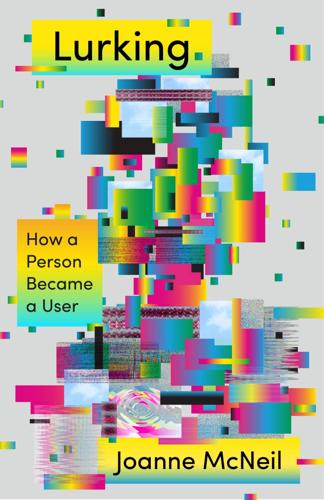
Lurking: How a Person Became a User
by
Joanne McNeil
Published 25 Feb 2020
Another stunning work is Why’s (Poignant) Guide to Ruby, a poetic, transgressive, and strange online document, with illustrations and recursive humor, that also happens to be one of the first guides to the Ruby programming language. The author, who was known as Why the Lucky Stiff, or “_why,” had a restless Pynchonian humor (and disappeared from public life, like him). Other work just never materialized, like Ted Nelson’s impossible dream of Project Xanadu, a goal since 1960 for universal electronic publishing with version control and unbreakable links—hypertext vaporware, which lives in the hearts of many internet old-timers, like Alejandro Jodorowsky’s unrealized film of Dune. Unfocused internet-hating in culture writing happened alongside uncritical, even fanboyish reporting on the tech industry that appeared in business sections.

Free as in Freedom
by
Sam Williams
Published 16 Nov 2015
As an author, I was willing to let other people amend my work just so long as my name always got top billing. Besides, it might even be interesting to watch the book evolve. I pictured later editions looking much like online versions of the Talmud, my original text in a central column surrounded by illuminating, third-party commentary in the margins. My idea drew inspiration from Project Xanadu (http://www.xanadu.com/), the legendary software concept originally conceived by Ted Nelson in 1960. During the O'Reilly Open Source Conference in 1999, I had seen the first demonstration of the project's open source offshoot Udanax and had been wowed by the result. In one demonstration sequence, Udanax displayed a parent document and a derivative work in a similar two-column, plain-text format.

Troublemakers: Silicon Valley's Coming of Age
by
Leslie Berlin
Published 7 Nov 2017
There have been many great technical visionaries whose ideas never reached full expression under the visionary’s guidance. In Taylor’s own day, indeed within a few miles of the Xerox PARC office, there were two. In the 1970s, Ted Nelson, who coined the word “hypertext,” wrote about a complex information architecture called Project Xanadu that never came to fruition, despite anticipating and in some ways exceeding the World Wide Web. Likewise, many of Douglas Engelbart’s ideas were not realized until they were refined at PARC, in the computer science and systems science labs. Taylor was different. He could recruit to PARC an outstanding group of researchers—selected based on his belief that “a very good researcher was worth two dozen good researchers”—and keep them working together for years.18 He also had the support of his boss, Jerry Elkind, who handled much of the lab’s administrative work.
…
game, 278 Pitzer, Kenneth, 57 Pixar-Disney Animations, 23, 101, 298 Pong game, xvi, 112–23, 130–31, 170, 208, 209, 221 Poniatoff, Alexander M., 37 Powertec Systems, 86–87, 177 Pribilla, Peter, 370 printed circuit boards, 42–44, 47, 117, 123, 162, 207, 228, 233 Procter & Gamble, 60 programming languages, 18, 65–66, 97, 149, 179, 209–10, 285, 314, 365 Project Xanadu, 95 public domain, 267 punch-card batch processing, 9–10, 18, 65, 149, 179 Quist, George, 84, 259, 262 Radio Shack, see Tandy/Radio Shack Raffensperger, Ron, 164n, 353–55 Raiders of the Lost Ark game, 275 Rains, Lyle, 130 Raytheon, 22, 28 RCA, 250 Rea, Bill, 309–12 Reagan, Ronald, 33–36, 255, 331 recombinant DNA, xii, xiv, 133–45, 157, 187–89, 195–96, 203–5, 256–64, 349–51, 374 Rector, James, 35 Redwood City, Calif., 4, 37 Reid, Brian K., 342 Reimers, Niels: biotechnology industry and, xvi, 138–40 and Boyer, 135–43, 194, 200–201, 208, 256–57, 260–67 and Cohen, 133–38, 141–44, 189 Genentech and, 264–68 navy career of, 58 at Stanford Office of Technology Licensing, xvi, 58, 132–45, 157, 187–89, 202–5, 264–68, 349–51, 374 and Swanson, 194, 202–3 Research Corporation, 59, 62, 132, 144 Research Craft, 49 Rhode Island, University of, 61 Richeson, Eugene, 44 Richion, Bill, 86–87 Ring, Dave, 352 River Raid game, 278 Roberts, Lawrence G., 18–21, 28 Robinett, Warner, 275 Roche, 375 Rock, Arthur, 90, 129, 149–50, 249, 258, 293–94, 372 Rockefeller, David, 293n Rolling Stone, 90, 143, 226 ROLM Corporation: CBX system and, 160–61, 308, 312, 352 Fawn Alvarez at, 41–46, 159, 222, 309–12, 370 founders of, 44, 160–65 growth of, 166, 310–11 IBM’s acquisition of, 353–55 as military contractor, 41, 45, 86 production work at, 159–67 Silicon Valley location of, 312 Vineta Alvarez at, 41, 44–45, 159 voice mail and, 352 Rosen, Ben, 253, 303n, 361n Ross, Steve, 172–73, 270, 273, 344–46 Rowland, Bertram, 141–42, 188, 203, 264 Russell, Steve, 108 Salesforce.com, 321, 371 Sandia National Laboratories, 50, 335 San Francisco, Calif., 3, 25–27, 34, 69, 74, 87, 173–74, 192, 239, 276, 296 San Francisco Business Journal, 322 San Francisco Chronicle, 187 Sanger, Frederick, 263 San Jose, Calif., 4, 49, 69, 157, 244 San Jose Mercury News, 254, 264, 300–301, 322 Santa Clara, Calif., 41, 117, 120, 130, 149, 166, 207 Schaefer, Catherine de Cuir, 296 Schneider, Nelson, 256n Science, 143, 266 Science and Technology, 22 Scientific American, 194 Scientific Data Systems (SDS), 90, 93, 101–2, 149, 215, 249, 335 Scott, Dana S., 342 Scott, Mike, 50, 149, 234–38, 242–43, 247, 297–301, 358 Sculley, John, 357–58, 372–73 Seagate, 361 search engine business, 343, 367 Sears, 129–30, 170, 247 Seckler, Liz, 182–83, 323–25 security clearance, 44, 49, 57 semiconductor industry, xi–xii, xiii, 3–5, 42, 47–48, 73, 102, 127, 147, 151–53, 169, 207, 212–13, 230, 242–43, 249, 272, 302, 366 Semiconductor Industry Association, 254, 373 Service Bureau Corporation, 65 Shockley, William, 4, 42, 60, 66, 190 Shoup, Richard, 96 Shugart, Al, 245 Silicon Graphics, 23, 253, 332, 365 Silicon Valley: biotechnology industry in, xiii, xiv, xvi, 138–40, 187, 194, 256–58, 262, 349, 366, 375 early start-ups in, 4–5, 44–45, 73, 76, 146 electronics industry in, 3–5, 42–44, 47, 74, 165, 170 employment in, 3–4, 151, 253–54, 274 entrepreneurs in, see entrepreneurs hobbyists in, 210–14, 230, 244, 247, 284 lobbying and, xiii, xiv, 254–55, 366, 373 manufacturing businesses in, 74, 78–79, 83, 88, 160, 253, 312–13 microchip companies in, 3–5, 42, 47–48, 127, 169, 207, 213, 230, 302 orchards in, xiii, 4, 43, 46, 49, 149, 180, 370 population of, 3–5, 367 “Silicon Valley USA” (Hoefler), 73 Simonyi, Charles, 96, 224, 288 SLAC (Stanford Linear Accelerator Center), 59 small computers, 283–85 see also personal computers smartphones, xiv, 358 Smith, Alvy Ray, 101 Smith, Hank, 148, 249, 293n Smith, Jeff, 309–10 Snapchat, 365 social networking, 367 Software Dimensions, 370 software industry, 21, 76–78, 80, 83, 91, 148, 157, 183, 222, 269, 289, 306, 316–17, 360, 371 Sonsini, Larry, 84, 165, 277, 296, 326, 371–72 Southern California, University of, 47–49 Southern California Computer Society, 212 Space Invaders game, 274, 278, 344 Space Race game, 120n Space Technology Laboratories, 48 Spacewar!

You Are Not a Gadget
by
Jaron Lanier
Published 12 Jan 2010
Entrenched Software Philosophies Become Invisible Through Ubiquity An even deeper locked-in idea is the notion of the file. Once upon a time, not too long ago, plenty of computer scientists thought the idea of the file was not so great. The first design for something like the World Wide Web, Ted Nelson’s Xanadu, conceived of one giant, global file, for instance. The first iteration of the Macintosh, which never shipped, didn’t have files. Instead, the whole of a user’s productivity accumulated in one big structure, sort of like a singular personal web page. Steve Jobs took the Mac project over from the fellow who started it, the late Jef Raskin, and soon files appeared.

This Is for Everyone: The Captivating Memoir From the Inventor of the World Wide Web
by
Tim Berners-Lee
Published 8 Sep 2025
In a 1945 Atlantic article, ‘As We May Think’, Vannevar Bush, scientific adviser to the US president, had theorized about a kind of ‘non-linear information retrieval’ system that would allow users to create trails of links between documents, mimicking the associative processes of the human mind. Influenced by Bush’s work, in 1963 the visionary entrepreneur Ted Nelson coined the terms ‘hypertext’ and ‘hypermedia’ as part of an ambitious computing platform he termed Project Xanadu. Nelson envisioned a universal, interconnected information space where every piece of content could be linked to every other piece, reflecting the non-linear nature of human thought. The system worked through a centralized system, which could ensure the integrity of all links and backlinks, to be run by the Xanadu Operating Company.

The Internet Is Not the Answer
by
Andrew Keen
Published 5 Jan 2015
According to Stasiland author Anna Funder, Mielke’s organization might have turned as many as 15% of all East Germans into one kind of data thief or another.4 Known as “the Firm” to East Germans, Stasi was attempting to transform the whole of East Germany into a real-time set of Rear Window. The country was, as Big Data authors Viktor Mayer-Schönberger and Kenneth Cukier note, “one of the most comprehensive surveillance states ever seen.”5 Like Ted Nelson’s Xanadu project to develop hypertext, Mielke’s East Germany eliminated the concept of deletion. “We had lived like behind glass,” explained the novelist Stefan Heym. Mielke organized his society around the same kind of brightly lit principles that the architect Frank Gehry is now using to build Facebook’s new open-plan office in Silicon Valley.

The Truth Machine: The Blockchain and the Future of Everything
by
Paul Vigna
and
Michael J. Casey
Published 27 Feb 2018
Those geeky rebels of the 1990s Bay Area wanted an Internet that was free of both government and corporatist control, a decentralized online economy where self-expression was devoid of censorship, where anyone could transact with anyone else under whatever identity they chose. Ideas like Ted Nelson’s ill-fated Xanadu project, which never achieved anywhere near its lofty vision of a global network of independent, self-publishing, interlinked, fully autonomous computers, envisaged a network in which far more processing power and data was placed under the control of individual owners’ computers. They were ideas that were far ahead of their time, conceived at a moment when resource, economics, and political realities simply weren’t compatible with them.
…
New York Times columnist Thomas Friedman: Thomas Friedman, The World Is Flat: A Brief History of the Twenty-First Century (Farrar, Straus and Giroux, 2005) In The Age of Cryptocurrency, we reported: Paul Vigna and Michael J. Casey, The Age of Cryptocurrency (St. Martin’s Press, 2015), pp. 57–60. This was not the dream conveyed: Timothy C. May, “The Crypto Anarchist Manifesto,” https://www.activism.net/cypherpunk/crypto-anarchy.html. Ideas like Ted Nelson’s ill-fated Xanadu project: For a detailed analysis of the Xanadu Project’s sweeping vision but failed implementation, see: “The Curse of Xanadu,” Wired, June 1, 2015, https://www.wired.com/1995/06/xanadu/. These people included Marc Andreessen: Don Tapscott and Alex Tapscott, Blockchain Revolution: How the Technology behind Bitcoin Is Changing Money, Business and the World (Portfolio, 2016), p. 5.
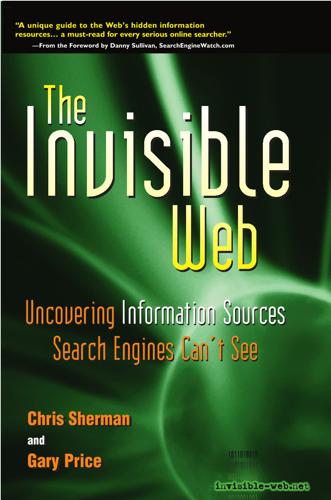
The Invisible Web: Uncovering Information Sources Search Engines Can't See
by
Gary Price
,
Chris Sherman
and
Danny Sullivan
Published 2 Jan 2003
“Accessibility of Information on the Web.” Nature 400 (1999): 107-109. Leiner, Barry M, et al. A Brief History of the Internet. 10 Oct. 2000 (http://www.isoc.org/internet/history/brief.html) References 399 Notess, Greg. Search Engine Statistics: Database Overlap. 29 Nov. 2000 (http://searchengineshowdown.com/stats/overlap.shtml) Project Xanadu. 20 Nov. 2000 (http://www.xanadu.net) ResearchIndex. NEC Research Institute. 20 Dec. 2000 (http://www. researchindex.com) Speechbot. Compaq Corporate Research. 1 Dec. 2000 (http://www. speechbot.com) Understanding the Internet: Transcript. PBS. 14 Oct. 2000 (http://www.pbs.org/uti/utitranscript.html) The Web Robots Page. 18 Oct. 2000 (http://info.webcrawler. com/mak/projects/robots/robots.html) 400 This Page Intentionally Left Blank About the Authors Chris Sherman is President of Searchwise, a Boulder, Colorado-based Web consulting firm, and Associate Editor of SearchEngineWatch.com.

The Innovators: How a Group of Inventors, Hackers, Geniuses and Geeks Created the Digital Revolution
by
Walter Isaacson
Published 6 Oct 2014
Author’s interview with Marc Andreessen. 43. Berners-Lee, Weaving the Web, 70; author’s interview with Tim Berners-Lee. 44. Author’s interview with Marc Andreessen. 45. Author’s interview with Tim Berners-Lee. 46. Berners-Lee, Weaving the Web, 70. 47. Berners-Lee, Weaving the Web, 65. 48. Ted Nelson, “Computer Paradigm,” http://xanadu.com.au/ted/TN/WRITINGS/TCOMPARADIGM/tedCompOneLiners.html. 49. Jaron Lanier interview, by Eric Allen Bean, Nieman Journalism Lab, May 22, 2013. 50. John Huey, Martin Nisenholtz, and Paul Sagan, “Riptide,” Harvard Kennedy School, http://www.niemanlab.org/riptide/. 51. Author’s interview with Marc Andreessen. 52.
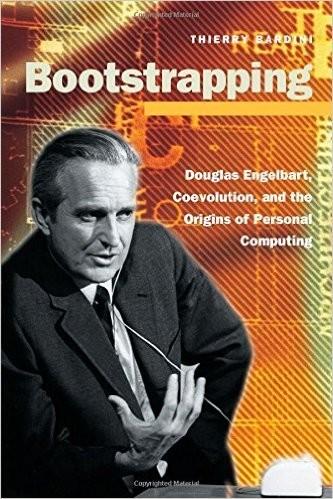
Bootstrapping: Douglas Engelbart, Coevolution, and the Origins of Personal Computing (Writing Science)
by
Thierry Bardini
Published 1 Dec 2000
The situation is more complicated than that. 5 For the development of hypertext, the important distinction is not between personal access to information and communication, but between dif- ferent conceptions of what communication could mean, and there were in fact two different approaches to communication at the origin of current hypertext and hypermedia systems. The first is represented by Ted Nelson and his Xanadu Project, which was aiming at facilitating individual literary creativity. The second is represented by Douglas Engelbart and his NLS, as his oN-Line System was called, which was conceived as a way to support group collabo- 40 Language and the Body ration. The difference in objectives signals the difference in means that char- acterized the two approaches.
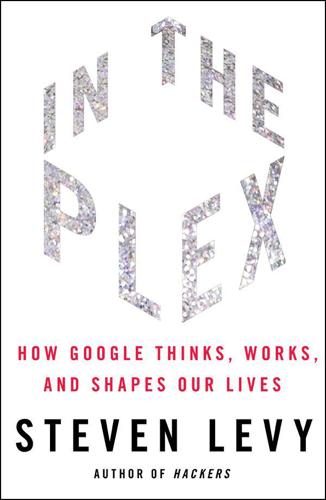
In the Plex: How Google Thinks, Works, and Shapes Our Lives
by
Steven Levy
Published 12 Apr 2011
The timeline continued to the work of Douglas Engelbart, whose team at the Stanford Research Institute devised a linked document system that lived behind a dazzling interface that introduced the metaphors of windows and files to the digital desktop. Then came a detour to the brilliant but erratic work of an autodidact named Ted Nelson, whose ambitious Xanadu Project (though never completed) was a vision of disparate information linked by “hypertext” connections. Nelson’s work inspired Bill Atkinson, a software engineer who had been part of the original Macintosh team; in 1987 he came up with a link-based system called HyperCard, which he sold to Apple for $100,000 on the condition that the company give it away to all its users.

Is the Internet Changing the Way You Think?: The Net's Impact on Our Minds and Future
by
John Brockman
Published 18 Jan 2011
Now there is a nearly infinite pool of accessible information that becomes my knowledge in a heartbeat measured in bits per second. For those of us who wallow in the world of knowledge for pleasure and profit, the Internet has become a vast extension of our potential selves. The modern Internet has achieved much of what Ted Nelson articulated decades ago in his vision of the Xanadu project, or Doug Engelbart in his human augmentation vision at SRI. Nearly all useful knowledge is now accessible instantaneously from much of the world. Our effective personal memories are now vastly larger—essentially infinite. Our identity is embedded in what we know.
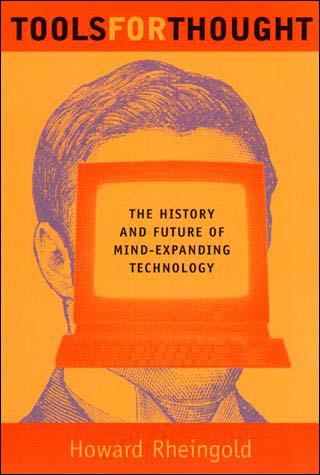
Tools for Thought: The History and Future of Mind-Expanding Technology
by
Howard Rheingold
Published 14 May 2000

The Inevitable: Understanding the 12 Technological Forces That Will Shape Our Future
by
Kevin Kelly
Published 6 Jun 2016

Dawn of the New Everything: Encounters With Reality and Virtual Reality
by
Jaron Lanier
Published 21 Nov 2017
Ivan Sutherland has been pursuing “asynchronous” computer architectures for years now. These are hardware systems without a master clock, but the implication is deeper; that computation can be fundamentally less localized and hierarchical. It’s been a long haul for him. Similarly, Ted Nelson is still working with a shifting group of students and followers to implement Xanadu, the original design for a digital network, which he started on in 1960. I’m convinced it would be better than the World Wide Web, but no one can know until there’s a fuller implementation. The idealist projects of computer scientists aren’t the ones that end up running the world, but they have indirect influence.

Track Changes
by
Matthew G. Kirschenbaum
Published 1 May 2016
To this way of thinking a word processor is merely an arbitrary instantiation or just one particular configuration of the universal machine that is a modern digital computer. The technorati have often shown surprising disdain for word processing on exactly these grounds. Ted Nelson, for example, visionary author of the book Literary Machines (1980) and founder of the Xanadu project, has frequently inveighed against programs like WordStar and Word that are based on the WYSIWYG model. For him, these represent the triumph of a fundamentally conservative vision. “A document,” he laments, “can only consist of what can be printed.”63 Jay David Bolter, a classicist who was an early advocate for computers as writing tools, rendered much the same verdict, concluding that word processing was “nostalgic” in its respect for the aesthetics of print.64 In this view, the promise and potential of newer, more experimental modes of electronic writing—including nonlinear hypertext, a term Nelson himself coined and has popularized throughout his career—is at odds with a technological paradigm whose highest achievement lies in mimicking the appearance of something that might have come from Gutenberg’s own press.65 Scholarly interest in the history of electronic literature has similarly gravitated overwhelmingly toward those authors who sought to reimagine our definitions of the literary through branching, multimodal, and interactive narratives or poetic compositions.

The Transhumanist Reader
by
Max More
and
Natasha Vita-More
Published 4 Mar 2013